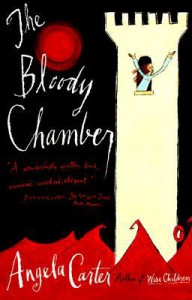The Bloody Chamber: And Other Stories

Hey there Little Red Riding Hood,
You sure are looking good.
You’re everything a big bad wolf could want.
Listen to me…
I don’t think little big girls should
Go walking in these spooky old woods alone.
—Sam the Sham and the Pharaohs, 1962
In The Bloody Chamber, Angela Carter’s uses a decidedly feminist slant to re-tell familiar myths and stories. “The Company of Wolves,” for example, provides a point-by-point rebuttal of the myths embedded in the more modern versions of “Little Red Riding Hood.” Interestingly, the earliest versions of the fairy tale were primarily oral and far more risqué. These versions included sexual elements such as the wolf (actually a “werewolf” in the oldest versions) telling Red Riding Hood to throw her clothes, one by one, into a fire (Leeming and Sader 391). Further—in these early versions—Red Riding Hood tricks the wolf by pretending that she needs to go outside to relieve herself. Once outside, Red Riding Hood quickly removes the rope attached to her, ties it to a tree, and escapes (Bushi). In these original versions, Red Riding Hood outwits the fox, and the sexual overtones are explicit.
By the time Charles Perrault wrote his version in 1697, the story had been sanitized into a lesson on young girls’ morality. In Perrault’s version, the story serves to warn young girls about the threat men pose to their sexual innocence, but does not include the mother’s warning to “stay on the path,” that appears in most later versions (such as that of Wilhelm and Jacob Grimm in 1812). Instead, Perrault ends his tale with an overt moral warning: Young ladies—in particular, well-bred and attractive young ladies—should not be beguiled by men’s wolfish charm (3). Jacob and Wilhelm Grimms’ version [originally called “Little Red-Cap”:], far more familiar to American and English audiences than that of Perrault, casts Little Red Riding Hood as a younger girl (i.e., even more vulnerable) and begins with the famous warning: “[W:]alk nicely and quietly and do not run off the path.” Predictably, Little Red Riding Hood forgets her mother’s warning, strays off the path, and gets “deeper and deeper into the wood.” Once in the woods, Little Red Riding Hood’s troubles begin. Ultimately, a hunter, who just happens to be passing by, saves her.
Of most significance is the decided shift the fairy tale has undergone through time. In the original versions, Little Red Riding Hood saves herself and is never gulled by the wolf. In versions dating from the seventeenth century onward, the girl strays from the path, actually believes the wolf might really be granny, and is saved by a huntsman. Further, in the Grimms’ version and its modern variations, Red Riding Hood’s comment at the end of the story demonstrates that she has learned her lesson: “As long as I live, I will never by myself leave the path, to run into the wood, when my mother has forbidden me to do so.” However, the fairy tale’s other messages to young women are more embedded and more destructive: We are easily distracted and disobedient; we are not safe alone in the woods (traveling off the beaten path); we are fairly stupid; we get ourselves in trouble; and we need to be rescued by a man.
In contrast, Angela Carter’s short story, “The Company of Wolves,” restores the tale’s original elements—such as the overt sexuality and a heroine who is resourceful rather than helpless—but adds a feminist perspective. Carter’s heroine is “strong-minded,” packs a carving knife in her basket of goodies, and is powerful because of her virginity:
Further, in Carter’s version, Red Riding Hood does not just protect herself, but controls the “game.” The seduction scene plays out like a modern slasher movie. As the girl—at the wolf’s bidding—removes each item of clothing and ostensibly becomes more and more vulnerable, we begin to see her as a victim. Just as we become lulled by the predictable script in motion, the girl, now completely naked, responds to the wolf’s threat, “All the better to eat you with,” by bursting into laughter: “[S:]he knew she was nobody’s meat.” Even given the background Carter provides in the story’s beginning, the scene startles. We knew the girl was strong, independent, and armed. However, the pattern of woman-alone-traveling-alone-helpless-alone-victim is so embedded in our consciousness that we are caught off-guard.“She stands and moves within the invisible pentacle of her own virginity. She is an unbroken egg; she is a sealed vessel; she has inside her a magic space…she is a closed system; she does not know how to shiver. She has her knife and she is afraid of nothing.”
And, that is precisely Carter’s point.
Adapted from a prior publication




